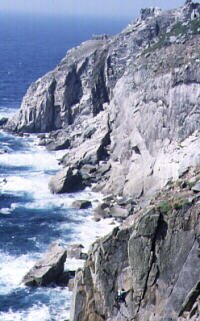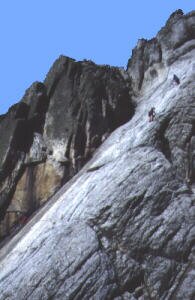 Our adventure (a trip to Lundy Island is not just a climbing trip - it's an adventure), started half an hour after the MS Oldenburg, the ferry that we were supposed to have been on, had sailed for the island.
A veritable fortress, with huge granite walls reaching 300 ft in places, Lundy Island is as famous for its climbing as it is for the pirates, villains and heroes that once inhabitated it's shores. Sailing from Ilfracombe, one immediately experiences a sense of wildness and adventure. This is not just a drive to the local crag. It is a climbing trip that lives on in memory long after the sun has set on many other climbing trips, both near and far! First climbing-sortie to Lundy happened in the late 1890s. Though the records have never been discovered, it is nevertheless known that Tom Longstaff climbed on St James' Stone. And so, the recorded climbing history on Lundy Island start in June 1961, when a party consisting of Admiral Keith Lawder, Ted Pyatt, Jimmy Logan and Robin Shaw paid their first visit to the island. On this ocassion they opened what is considered the first classic line on Lundy: The Devil's Slide. Except for climbs like Albion (on the Devils's Slide), and Diamond Solitaire, little else of real noteworthiness happened until 1970.
The taste of salt-water thoroughly washed from our lips after a short stop in the Marisco Tavern, and a quick introduction to the early Climbing History of Lundy completed, John and I headed for Landing Craft bay. Close to the campsite, easy to descend, and offering some superb climbing in the VS and up range, it is a great starting point for anyone not used to the rock or local conditions. Road Runner, a very pleasant 90ft VS, first climbed in 1972 by Gilbert, Littlejohn and Moulton, becoming our first 'prize' in an active four days of climbing.
Next day, a precarious abseil, takes us close to the base of the classics Shamrock, and the adjoining Holiday in Cambodia. Shamrock proves a tricky take-off, but otherwise fairly easy, well-protected climb. Holiday in Cambodia is exactly that! I have the honour of leading the top pitch; described as of "spartan protection." Which, translated into everyday language means: More than halfway up this wall, your last piece more than a sure-as-hell, hit-the-deck head-splitting fall below you, you suddenly get the urge to put in just one more piece of 'pro'. But even the most careful of searches doesn't yield even the tiniest of spaces. An, oh s**t I forgot the epoxy, which may have been a last desparate resort, flashes through the brain (what brain?). The urge to look down to where the last piece, more of a decoration than real protection, shines in the glorious sun, becomes overpowering. If you have any common sense left (you wouldn't have been here in the first place) you fight the urge to look down, find the next little hold, and move on. Every move at this point becomes one of extreme concentration... like soloing - albeit involuntarily. Then, at last, what feels like a thousand feet higher, you find another place where a 'decorative' piece of gear makes you feel just that teensiest bit more confident. You also know that if you fall at the wrong angle, that not even this huge wire is going to stop you from looking like a gannet plummeting to the surface of the sea! A half-a-dozen easier moves later, you top out onto easy ground, and you yell at the top of your lungs, because if you don't you'll start shaking... Suddenly it dawns on you that this is climbing in it's purest form. Challenging, technical, adrenaline zapping, beautiful, thin positive holds on a huge wall that make you feel tinier and tinier the higher you progress. And you want more.... John's turn to take the thin end. This time it's Formula One. Another superb, sustained line done, one throwing all kinds of technical problems at you, we decide we've done enough for today and head for the tavern. Tuesday morning - final day. I head off with Richard, as Paul and John head off in a different direction. We settle on 'Double Diamond', which Richard hadn't previously done; I find that the angry sea below is less of a threat today! Time for one more climb before the ferry leaves. It has to be Needle Rock - a solitary sea-stack, which in high tide is completely surrounded by huge lapping tongues of water. Integrity being the 3-star route, we choose it for our last outing. A feeling of airiness follows one all the way to the top on this short but sustained pitch. For a short while you sit on top of the small platform and you look down at the sea surrounding you. But you dont stay too long as you know that you have to get back to the mainland before the incoming tide cuts off your retreat line, and leaves you wet or marooned. The ferry ride back is a lot more confortable, but a lot less exciting than the ski-boat that brought us here. The main consolation being the cold beers, and the fact that you can sit down without fear of being washed overboard! Next year it will definetely be a seven-day trip to this little four by half mile rock fortress. With more than 500 superb routes to pick from, and many more just waiting to be climbed, no crowds, no pollution, plenty of beer and good company, where else would you want to go? Climbing Guide Books
How to get there, wildlife, etc, at the Lundy Website (recommended!) © 1996/1997, Mountain Online " Contents " © 1996/97, Ikhaya WebServices |


